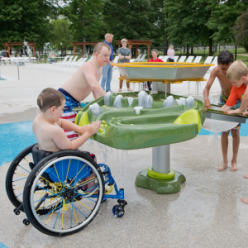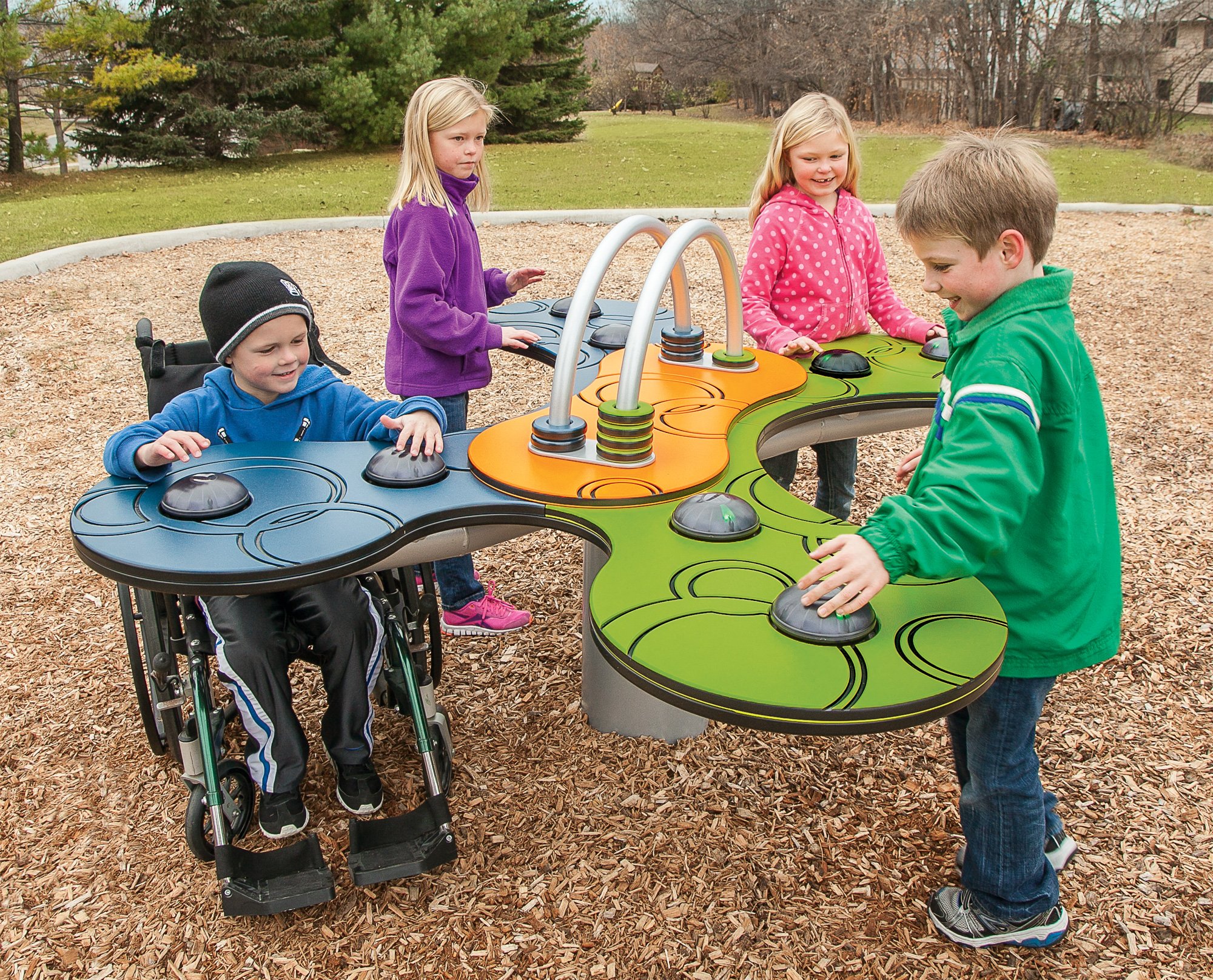Welcome and Support All Playground Visitors with Inclusive Design
 Landscape Structures’ design philosophy is heavily influenced by the tenets of Inclusive Design, a theory of design that strives to make environments more usable, safer, and healthier for all. This philosophy has been part of the company’s commitment to inclusion since co-founder, Steve King, was appointed to the Federal Access Board’s Recreation Access Advisory Committee in 1993.
Landscape Structures’ design philosophy is heavily influenced by the tenets of Inclusive Design, a theory of design that strives to make environments more usable, safer, and healthier for all. This philosophy has been part of the company’s commitment to inclusion since co-founder, Steve King, was appointed to the Federal Access Board’s Recreation Access Advisory Committee in 1993.
Inclusive Design favors equity over equality. Equality means each individual or group of people is given the same resources or opportunities. Equity recognizes that each person has different circumstances and allocates the exact resources and opportunities needed to reach an equal outcome. Inclusive Design goes beyond providing everyone access to an even playing field… it delivers a chance to thrive on it.
Inclusive Design looks for solutions that fit everyone: young, old, all levels of ability, parents with a stroller… everyone. Inclusive design is a human-centered approach to design that aims to apply to as diverse a range of people as possible.
Our team of designers, engineers, and inclusive play experts follow the Seven Principles of Universal Design, created by a group led by Ronald Mace at North Carolina State University :
- Equitable Use. The design is useful to people with diverse abilities. This principle seeks to include as many people, of all abilities, in the use of a product as possible. For example, the use of a poured-in-place surface or turf with seamless transitions is key to universal access. People using mobility devices could roll on it as smoothly as non-users could walk on it. The We-Go-Round®, We-Go-Swing®, and Sway Fun® glider are all examples of playground components that fit this category.
- Flexibility in Use. The design accommodates a wide range of individual preferences and abilities giving users a choice in how they engage in each activity. Flexibility in use offers choice to users, and a great example of this is the We-Go-Round. Individuals in wheelchairs can roll on and stay in their chairs or choose to transfer to the seat—they have a choice and can participate in the way they feel most comfortable. Other examples include the sand table at different heights or multiple types of swings with unitary surfacing paths. This flexibility of design should include elements like seating, sinks, hand dryers, adult-sized changing tables, etc. throughout the park and playground that make them accessible for a wide variety of body heights and types and that give people the option to find their flexible fit.
- Simple and Intuitive Use. The use of the design is easy to understand regardless of the user’s experience, knowledge, language skills, or current concentration level. If an individual sees a drum, they know what to do with it. If they see the OmniSpin® Spinner, they know where to push it to make it go and where to sit to ride. It doesn’t cause stress or complications trying to figure it out. The design needs to provide a balance between simple, intuitive design and more challenging play space events to make sure all playground visitors have an opportunity to play and explore.
- Perceptible Information. The design communicates necessary information effectively to the user regardless of ambient conditions or the user’s sensory abilities. Symbol communication signs are a great tool to help all users communicate effectively while visiting parks and playgrounds. For example, splash pads have a lot of rules—like “no eating” that could easily be understood with a little circle crossing out food. It’s a more universal method of communication that all people can understand. Additionally, the use of color contrast and textures provide cues on changes in elevation, alerts individuals to busier areas, and more.
- Tolerance for Error. The design minimizes hazards and the adverse consequences of accidental or unintended actions. With this design principle, planners discuss adding a fence to play space to help keep kids that may wander or run away. Another example is incorporating barriers on a playground structure, which is meant to reduce the chances of a child accidentally backing up and falling off. Additionally, examples of this principle in surfacing are when there is mixed safety surfacing such as wood chips with rubber, the woodchips must stay maintained so that there aren’t any major drop-offs to create hazards. Or if there is a sand table or structure where a wheelchair is meant to roll underneath, the surfacing should extend underneath the front wheels to avoid having the users tip forward.
- Low Physical Effort. The design can be used efficiently and comfortably. Anything that keeps a visitor more comfortable for longer, is considered part of this low physical effort principle. Commercial shade structures that keep surfaces cool or gradual, and low grades throughout the playground are part of the consideration. Additional considerations should be swing seat choices such as Molded Bucket Seats. A child who fatigues a bit quicker, with the Molded Bucket Seat on a structure like the ZipKrooz®, can still get that zooming sensation, but in a reclined position that is less demanding on them.
- Size and Space for Approach and Use. Appropriate size and space are provided for approach, reach, manipulation, and use regardless of the user’s body size, posture, or mobility. This principle gives people the chance to move around comfortably. If a standard sidewalk is 36 inches wide and a wheelchair is 26 of those inches, there is no room for anyone to move through the space alongside the wheelchair user. Providing extra wide paths allow users with mobility devices, or someone with a cane or service dog, a more comfortable experience. This principle also applies to items like double-wide ramps and activity panels on the playground. Is there room for someone to push up to the structure and play with it? Or if a wheelchair user is engaging with a play structure, is there enough room for others to get around the chair?
Through Inclusive Design, we increase access, safety, comfort, and social participation within all our play environments. This process creates a strong foundation for inclusive playground design that ultimately results in a place where all can play, learn and grow together. Learn more about the commitment that Landscape Structures and Whirlix have to inclusive play at playlsi.com.

